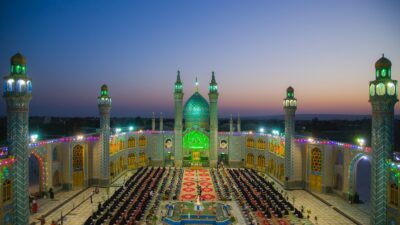
Due to lack of sources, the early history of the Ismā‘īlīs (i.e. the period 148 -264 /765-877) is shrouded in mystery. Very little is known about their activities in this early period. Following the death of the Shia’s twelfth Imam, the entire Shi’i movement was thrown into confusion. The eleventh Imam had died childless, and thus an entire story was fabricated about the miraculous birth and subsequent hiding (ghayba) of the alleged twelve Imam. At the time however, there was huge doubt amongst the Shias regarding the actual existence of the 12th Imam. Those who did believe in him were perturbed by his long absence. This period, known as the hayra (confusion), presented an ideal opportunity for an opposing faction of Shī‘īs to propagate what was to become known as Ismā‘īlī Shī‘īsm. This started in Kūfa in 261/875, and later spread to Iran1. Many Imāmi Shī‘īs embraced the Ismā‘īlī da’wa, which preached that the grandson of their sixth Imam Ja‘far al-S̩ādiq, Muh̩ammad b. Ismā‘īl, had not died but had gone into occultation and would reappear as the Mahdī.2 See this link for further details.
The Ithnā ‘Asharīs (or twelvers) on the other hand, held that Ja‘far al-S̩ādiq’s son Mūsā was his rightful successor.3 At this stage, the proto-Ithnā ‘Ashariyya were not propagating the concept of the Mahdī, as there was still a lack of clarity regarding the nature of the twelfth Imām’s ghayba.
Ismā‘īlī propagandists were sent to Yemen, Sind, Syria, eastern Arabia, and North Africa. It was in Algeria, among the Kutāma Berbers, that the da‘wa had its greatest success. Unlike the proto-Ithnā ‘Asharīs, who after Ja’far as S̩ādiq took a quietist approach to politics, the Ismā‘īlīs were politically and militarily active. By 296/909, the Ismā‘īlīs had conquered most of northeastern Algeria and Tunisia. In 297/910, the Ismā‘īlī caliphate was declared, with ‘Abdallāh al-Mahdī (r. 296-322 / 909–934) its first caliph. It lasted until 567/1171, Egypt having been conquered in 358/969.
In the Imāmate of the Ismā‘īlīs both religious and (real) political authority were incorporated. With political authority came the issue of political succession, and like their ‘Abbāsids counterparts, the Fāṭimids experienced a number of succession crises, resulting in a number of splinter groups. The death of the Fāṭimid Caliph Mustanṣir (d 487 / 1094) led to the first succession crisis. The caliphate passed on to his younger son Mustaʿlī (d 495 / 1101) rather than his older son and heir apparent Nizār (d 488 /1095), who contested the accession. Nizār led an unsuccessful revolt, resulting in a permanent division between the Musta’līs who remained in power and the Nizārīs4. Under the leadership of Hasan-i S̩abbāh̩ (d 518 / 1124) the Nizārīs managed to establish small principalities in Iran and later Syria, which lasted until the Mongol invasion. The K̲h̲ōd̲j̲as and Bohorās are two contemporary offshoots of the Nizārīs.5
In 524 / 1130, a further split occurred amongst the ruling Musta’līs following the assassination of the Caliph Āmir (Mustaʿlī’s son). Āmir left behind a baby son, Tayyib, whose fate following his father’s death remains unknown. ‘Abd al Majīd, the cousin of the murdered Caliph Amīr, was officially designated the new Caliph. However, a Yemeni group of Ismā‘īlīs declared the Imāmate of Tayyib and refused to recognise ‘Abd al Majīd. This group, called the Tayyibis, which survives up to the present day, pronounced Tayyib to be in occultation.
The year 286/899 witnessed a major split in the Ismā‘īlī movement, leading to two factions, the Fāṭimids and the Qarāmiṭa. Up to this point, belief in the hidden Imām/Mahdī, who had representatives (known as the ‘Grand Masters) working on his behalf, was widespread. However, the fourth representative (called ‘Alī according to Halm) declared that he was the Mahdī; henceforth, one faction of Ismā‘īlīs now began to follow a living Imām6.
Not everyone accepted this new concept of Imāmate, and those who chose to remain with the ghayba model were known as the Qarāmiṭa. i.e. the Qarāmiṭa were still awaiting the return of the hidden Imām, Muh̩ammad b. Ismā‘īl. They had a large following in Iraq and Eastern Arabia, and in the latter region, they established territory from where raids were launched against pilgrim caravans, and in a brazen and direct challenge to the religious authority of the Caliph, the city of Mecca was attacked.
Following the seizure of the Black Stone in 317/930, the leader of Qarāmiṭa, Abū Tāhir declared a former Persian slave and a Magian to be the awaited Mahdī. But only a few months later, Abū Tāhir declared him to be an imposter and had him killed. This severely weakened the movement, and many of the Gulf Coast Qarāmiṭa turned to the Ithnā ‘Ashariyya, and a number of Iraqis turned to Sunnism. In 339/995, the Black Stone was returned in exchange for a large sum of money, and for a period of time, the Qarāmiṭa abandoned their belligerent policy towards the ‘Abbāsids. Hostility renewed between the Qarāmiṭa and the Fāṭimids after the latter took Egypt in 358/969, and at the same time, fighting occurred between the Qarāmiṭa and the pro-‘Abbāsid Ikhshids. In 378/988, after suffering a crushing defeat at the hands of the Buwayhids, very little was heard about the group.
Notes:
- Madelung, W., “Ḳarmaṭī”, in: Encyclopaedia of Islam, Second Edition; Heinz Halm,Shi’ism (New Edinburgh Islamic Surveys) 2nd edition 2004 p. 165. ↩︎
- Berkey argues that as a distinctive sect, the Ismā‘īlīs emerged a century after Ismā‘īl’s (d. 138 / 721) death. It was only in the 850s and onwards that they appeared in the historical records as an active movement. Berkey, 2003 p. 137. ↩︎
- Heinz Halm, The Shiites: A Short History, 2nd edn (Princeton: Markus Wiener Publishers, 2007), pp. 160-1. ↩︎
- Najam Iftikhar Haider, Shi’i Islam : An Introduction, (New York, NY: Cambridge University Press, 2014), pp. 128-9. Gibb, H.A.R.. “Nizār b. al-Mustanṣir.” Encyclopaedia of Islam, Second Edition. ↩︎
- Nanji, Azim. “Nizāriyya.” Encyclopaedia of Islam, Second Edition. ↩︎
- ‘Alī was also known by the pseudonym Sa’īd (the happy one). Ibid. p. 198. fn 38. The exact name of the first Fāṭimid caliph is a matter of dispute. According to Daftary, he was called Abū Muh̩ammad Abdāllah or Sa’īd. Daftary, 2007 p. 508. On the other hand, Canard. M refers to him as Ubayd Allāh. Canard, M., “Fāṭimids”, in: Encyclopaedia of Islam, Second Edition, ↩︎





